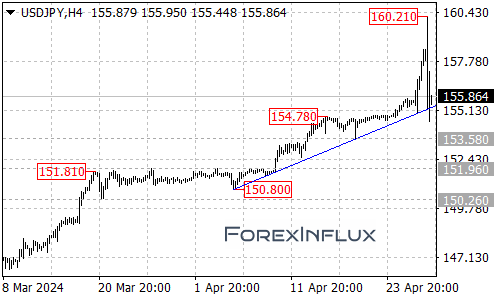The USDJPY currency pair has taken a bearish technical turn by breaking below the rising trendline support visible on the 4-hour chart timeframe. This breakdown suggests that the recent upside move from the 150.80 low may have already completed at the 160.21 high printed this week.

In the wake of this trendline violation, USDJPY may find itself stuck in a trading range over the coming days and weeks. The pair seems likely to oscillate between the key 154.50 support area on the downside and the 160.21 resistance zone on the topside as it works through this potential consolidation phase.
However, it’s important to note that the overall longer-term bullish outlook would remain viable as long as USDJPY can continue finding support above the 154.50 level. A sustained hold above 154.50 would leave the door open for the pullback from 160.21 to be treated as nothing more than a pause within the larger uptrend tracking from the 146.47 low set back in March.
In fact, if the currency pair can stabilize and muster enough strength for a breakout above the 160.21 resistance level, it could open the path for a resumption of the broader uptrend, potentially targeting the 162.00 handle next.
But for now, the technical breakdown below the rising trendline has shifted the near-term bias to more neutral or even slightly bearish. Any further losses that breach the 154.50 support would raise more significant downside risks.
Specifically, a break below 154.50 support would suggest that a more protracted corrective phase within the rally from the December 2023 low at 140.25 may be underway. Such a scenario could expose the 151.00 region as the next key downside target in the coming weeks.
The key levels to monitor are 154.50 support for any signs of a bullish reversal and continuation, 160.21 resistance for a potential upside breakout and resumption of the broader uptrend, or a breakdown below 154.50 to signal a more significant downside move could be in progress.
USDJPY traders will want to keep a close watch on the price action around those key technical zones for potential range-trading opportunities in the near-term while awaiting clearer signs on whether the uptrend will resume or if a deeper correction is set to unfold.